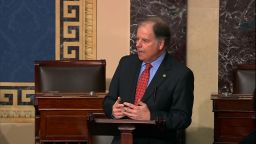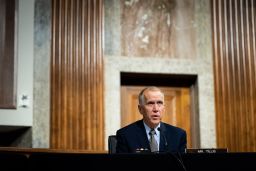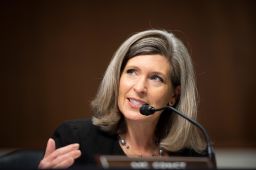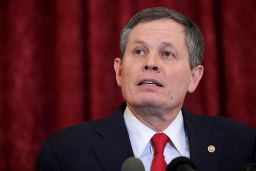The Senate majority is firmly within Democrats’ reach with just a week to go until Election Day.
That wasn’t necessarily expected a year ago, but Democrats’ improving fortunes have a lot do with President Donald Trump. Republicans breathed a sigh of relief after the second presidential debate last week, where they think the President at least didn’t hurt himself. But Trump has been a consistent drag on down-ballot Republicans, and he’s spurred Democrats to raise staggering sums of money.
Democrats in once-red suburban House districts started shattering fundraising records in the 2018 midterms, and now a similar dynamic is playing out across the Senate landscape, with Democratic challengers raising more in one quarter than incumbents and challengers – combined – used to raise in an entire cycle.
And while that money has helped Democrats expand the playing field deeper into Trump states – like South Carolina, Kansas and Alaska, for example – it’s not going unanswered in the final weeks of the campaign. Senate Leadership Fund, a GOP super PAC tied to Senate leadership, raised nearly $50 million in the first two weeks of October that it can use to level the playing field in red states where the Democratic candidates have had significant fundraising advantages. Conservative donor enthusiasm for the Senate underscores that Republicans think holding the chamber is their best firewall against Democratic-controlled government – a theme coming through in some GOP advertising in individual races.
A lot depends on the presidential race in the final stretch, since down-ballot races have become increasingly nationalized. In 2016, for the first time, every state voted for president the same way it did for Senate. For Senate Democrats looking at Democratic nominee Joe Biden’s poll numbers, that’s good news. Biden led Trump by 52% to 42% in CNN’s Poll of Polls as of Thursday and held margins of varying sizes in several states with key Senate races.
Interactive: 2020 Senate race ratings
Democrats need a net gain of four Senate seats to win the chamber if Biden loses. Assuming Democrats lose Alabama – which CNN has consistently ranked the seat most likely to flip this year – they need to flip five other seats. But if Biden wins the presidency, they need a net gain of only three since the vice president breaks ties in the Senate. Again, assuming they lose Alabama, Democrats would need to flip four seats.
Colorado and Arizona are top targets, and they’ve been consistently ranked No. 2 and 3, respectively, in CNN’s ranking of seats most likely to flip. The rankings are based on CNN’s reporting, as well as polling, fundraising and advertising spending data. There’s a handful of GOP-held seats that come next on the ranking that could put Democrats over the edge.
Besides Alabama, though, Democrats also have to keep their eye on Michigan – the only other state Trump won in 2016 where a Democrat is running for reelection. Even with Biden leading there, the Wolverine State rounds out the bottom of this ranking.
There are many more Republican trouble spots than Democratic trouble spots, though. Biden is doing better among White working-class voters than Hillary Clinton did in 2016, which is helping him narrow Trump’s margin in many red states. That gives Senate Democrats a chance to play offense – even if Trump is ultimately expected to carry those states.
In Kansas, for example, Trump was leading by just 7 points – down from his 21-point margin in 2016 – and GOP Rep. Roger Marshall was ahead by only 4 in a New York Times/Siena College poll from last week. Biden’s competitiveness in Texas has also given Democrats late optimism about the Senate race there, although it’s still a Lean Republican contest, according to Inside Elections with Nathan L. Gonzales, a CNN contributor.
Both parties acknowledge something would have to go horribly wrong for Republicans to lose the Senate race in Mississippi. But the spending disparity there is not to be ignored: Republican Sen. Cindy Hyde-Smith, who won a 2018 special election, raised just $84,000 during the first two weeks of October. During the same period, Democratic challenger Mike Espy raised nearly $4 million.
The Southern state that’s perhaps most concerning to Republicans is Georgia, where Biden is competitive and where not one but both Senate seats are at risk. The special election featuring Sen. Kelly Loeffler is almost certain to go to a runoff. The regular election, featuring GOP Sen. David Perdue, ranks seventh on this list. But if neither candidate gets a majority, which seems likely, it’ll also go to a runoff, which means that while Election Day is next week, the fight over the balance of the Senate could extend until January.
Here are the seats most likely to flip partisan control:
1. Alabama
Incumbent: Democratic Sen. Doug Jones

Ever since scandal-plagued Roy Moore lost the GOP nomination earlier this year, there hasn’t been much that could displace Jones as the most vulnerable senator of the year. Even against Moore, who was facing allegations of sexual assault, the Democrat only barely won a 2017 special election. He’s outraising and outspending Republican Tommy Tuberville, and his best path to victory remains turning out Black voters. But that doesn’t look like enough to overcome the partisan lean of the state. Trump won Alabama by 28 points, and unlike in some other red states he carried in 2016, where his margins are slipping, he’s holding up pretty well in the Yellowhammer State.
2. Colorado
Incumbent: Republican Sen. Cory Gardner

The president Gardner has chosen to put in one of his most recent ads isn’t the current occupant of the White House; it’s former Democratic President John F. Kennedy. That says a lot about this first-term Republican senator’s reelection fight in a state Trump lost by 5 points in 2016 and is likely to lose again this year. Gardner needs ticket-splitters, hence he’s touting the bipartisanship of his own work on conservation legislation but he also can’t afford to alienate the GOP base. That’s a difficult balance to strike, and one that doesn’t leave him with much of a path to victory. Democrat John Hickenlooper, meanwhile, has been putting Trump in his ads to tie Gardner to the top of the ticket. The former Democratic governor has faced his own stumbles, but the partisanship of the state during a presidential election year should help him become the next senator from the Centennial State.
3. Arizona
Incumbent: Republican Sen. Martha McSally

This is McSally’s second bid for Senate in as many years, and some of the dynamics that hurt her in that 2018 race are at play again this year. The former congresswoman, who was appointed to the open seat after losing last time, is still struggling to simultaneously appeal to Trump supporters and the suburban voters – especially women – who dislike him. The difference this year is that Trump is on the ballot with her. Depending on how he does in Arizona, that could give McSally a boost. But with Biden having an edge in several recent polls of the state, Trump could also drag her down. She’s facing a well-funded opponent in Democrat Mark Kelly, a NASA astronaut and the husband of former Rep. Gabrielle Giffords. Kelly led McSally 52% to 42% among registered voters in a Monmouth University poll from mid-October, a widening of his 6-point advantage from the same pollster in September. Underscoring McSally’s problem: Nearly half of Arizona voters said she had been too supportive of the President – and that was even higher among independents – compared with 38% of voters who said she’s given him the right amount of support.
4. Maine
Incumbent: Republican Sen. Susan Collins

The four-term senator is in the toughest fight of her career. And while Republicans hope voters in the state’s more conservative 2nd District may be coming home to her in the final stretch, she still faces a daunting path to reelection with the state’s use of ranked choice voting. She’s trying to hold on to ticket-splitting voters (who do still exist in Maine) while not alienating base voters who think she hasn’t been chummy enough with Trump. She hasn’t made the same commitment she did in 2016 not to vote for him. But there’s no love lost between Collins and the President, who tweeted earlier this month that she’s “not worth the work.” Democrats, however, are trying to nationalize the contest, eagerly pointing out all the times she’s voted with Trump, with Democrat Sara Gideon arguing this race is just as much about Senate Majority Leader Mitch McConnell’s fate as leader as it is about Collins. The senator may earn plaudits for being the only Republican to vote against Amy Coney Barrett’s Supreme Court nomination, citing the closeness to the election and the precedent set in 2016, but that probably won’t win her back voters who were enraged by her support of Justice Brett Kavanaugh in 2018.
5. North Carolina
Incumbent: Republican Sen. Thom Tillis

Republicans think they caught a break in North Carolina with Democrat Cal Cunningham’s sex scandal, especially if it gives conservatives a reason to vote for Tillis, who has long struggled to consolidate the Republican vote. Senate Leadership Fund has seized on the issue to argue the Army reservist is a hypocrite who lacks the character he’s campaigned on. Cunningham has now responded in his own spot saying, “Tillis is desperately attacking my personal life because he doesn’t want to talk about his own record.” He goes on to tell voters, “It may be my name on the ballot, but it’s your health care.”
Public polling, at least, seems to bear out Cunningham’s bet that voters don’t much care about his personal scandal. He led Tillis by 49% to 43% among likely voters in a CBS/YouGov poll released Sunday, with nearly an equal percentage of likely voters saying they disapprove of how each candidate handles himself personally. A Washington Post/ABC News poll from mid-October showed no clear leader, but 71% of registered voters said Cunningham’s affair was less important, while 81% said who controls the Senate was more important to them. Carrying that message, however, requires spending, and Cunningham entered the final stretch of the race with a cash-on-hand deficit. But in one of the states most saturated with political advertising, the Senate race may come down to what happens in the presidential contest, which has been consistently close here.
6. Iowa
Incumbent: Republican Sen. Joni Ernst

Both sides acknowledge this race is a coin toss. Trump carried the state by nearly 10 points in 2016. But now Ernst – the first woman elected to federal office in Iowa – is in the same boat as many GOP senators who need to convince voters why they deserve a second term, even if Trump doesn’t. A recent spot from the National Republican Senatorial Committee makes a checks and balances argument for rejecting Democrat Theresa Greenfield, implying that Senate control would be the last defense against a President Biden and Democratic House.
Ernst burst onto the political scene with her infamous 2014 “make ‘em squeal” ad, but she may not have done herself any favors in a recent debate, where she couldn’t state the price of soybeans. It’s not clear the moment has resonated beyond the headlines, but Republicans are worried that Greenfield – who talks about being a “farm kid” – has had a fundraising advantage. (She raised nearly four times as much as Ernst in the first two weeks of October.) A recent New York Times/Siena College poll had Ernst at 45% to Greenfield’s 44% and Biden at 46% to Trump’s 43% among likely voters – all within the margin of error. Monmouth’s poll from around the same time showed an essentially tied Senate race, as it has for much of the late summer and fall.
7. Georgia
Incumbent: Republican Sen. David Perdue

Biden’s trip to Georgia on Tuesday says it all – the state is in play, and that’s making Republicans nervous about holding on to both Senate seats, most immediately Perdue’s. The Atlanta suburbs are changing fast, and they’re populated with the kinds of well-educated and diverse voters who don’t like the President. Perdue has been outraised by Democrat Jon Ossoff, who lost the most expensive House race in history in 2017, and the GOP incumbent is still responding to Democratic attacks about his stock trades. Senate Leadership Fund aired an ad defending Perdue on the issue, an unusual and telling move since super PACs often stick to attacking opponents. A CBS/YouGov poll released Sunday had the race even, with Perdue at 47% to Ossoff’s 46% among likely voters, while a Quinnipiac University poll from earlier in the month gave Ossoff a 51% to 45% edge. Getting more than 50% on Election Day is Ossoff’s best path to victory. If neither candidate receives a majority, the contest advances to a January runoff, when Democrats might not have the same level of enthusiasm (and the spending) of a presidential race.
8. Montana
Incumbent: Republican Sen. Steve Daines

Another first-term Republican, Daines is facing two-term Democratic Gov. Steve Bullock, who’s proved he can win statewide at the same time Trump carries the state. The President isn’t expected to post anywhere near the 21-point margin he did in 2016 (a recent New York Times/Siena College poll gave him just a 6-point lead among likely voters). Which is why, in addition to attacking Bullock as being too liberal, Republicans have turned to a checks and balances argument here: “Imagine Biden, Pelosi and Schumer in charge – it could happen if Steve Bullock is elected to the Senate,” a recent National Republican Senatorial Committee ad says. Montanans are used to splitting their tickets, as Bullock’s 2016 reelection, and Democratic Sen. Jon Tester’s reelection two years later, showed. Since then, though, Bullock has run for president against Trump. And Republicans hope that with Trump on the ticket, the partisanship of Montana will be too much for Bullock to overcome. The New York Times survey had Daines at 49% and Bullock at 46%, within the margin of error.
9. South Carolina
Incumbent: Republican Sen. Lindsey Graham

If there’s any Senate race where the Supreme Court vacancy has altered the trajectory, it may be South Carolina, where Judiciary Chairman Lindsey Graham’s visibility during Barrett’s confirmation hearings gave him a prominent platform to raise money. Republican outside groups have also come to his rescue, with Senate Leadership Fund spending nearly $16 million in the state. Despite Democrat Jaime Harrison raising a record-breaking $57 million in the third quarter, he may be outspent in the final stretch. Republicans hope that Graham’s Judiciary Committee performance will also help him consolidate support among conservatives, who’ve long viewed him skeptically. Democrats are trying to exploit any lingering gap there, though, with Senate Majority PAC running ads about how Graham has criticized Trump while Harrison props up a third-party candidate as the true conservative. Bill Bledsoe already dropped out and endorsed Graham, but his name is still on the ballot. A New York Times/Siena College poll taken in mid-October (with the final days of interviews overlapping with the confirmation hearings) gave Graham a 6-point lead and Trump an 8-point lead. Democrats will also be closely watching the turnout of Black voters – a crucial voting bloc to get Harrison across the finish line.
10. Michigan
Incumbent: Democratic Sen. Gary Peters

Some recent public polling has shown a close race here. A New York Times/Siena College poll from early October, for example, put Peters ahead by just 43% to 42%, well within the margin of error. Republicans think that reflects the strength of their candidate, Iraq War veteran John James, compared with the first-term incumbent. But Democrats aren’t buying it, pointing out that Peters outraised James in the pre-general reporting period – a change from earlier in the year – and that Biden’s edge here should boost the incumbent. A Fox News poll from later in October gave Peters a 49% to 41% lead among likely voters, which is more in line with what one would expect if the Democrats are performing well here at the top of the ticket. Still, given the outside spending from both sides in the Senate race, this contest is worth keeping a close eye on.


















